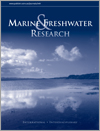Marine and Freshwater Research
Volume 72
Number 2 2021
There is a growing body of research highlighting the importance of saltmarshes as habitats for fish. However, more work is needed on fish use of vegetated saltmarsh flats. Our review of sampling methods and design, in particular our examination of suitability of methods in relation to environment, research question and practical considerations, will help inform sampling approaches in future studies investigating fish use of vegetated saltmarsh flats.
During the first few years of their life, lemon sharks occupy nursery areas within a range of latitudes, temperatures and habitat types. Variable environmental conditions among nurseries result in variable energy allocation towards growth in young lemon sharks and spatial variation in the role of individual nurseries in the broad lemon shark population. In this study, we examined age and growth of lemon sharks at a nursery area in Los Roques, Venezuela, and compared our findings with results from other nurseries.
Zooplankton dynamics of small tropical lowland rivers are poorly known but fundamental components of food webs. Herein we describe spatial and temporal patterns of the planktonic invertebrate fauna of a perennial river in north-eastern Queensland. Phytoplankton abundance was not limiting, and determinants of abundance and assemblage structure were physical: distance from estuary, salinity and flow regime, including the presence of slack waters.
An outbreak of crown-of-thorns starfish (Acanthaster planci) has become the figurative final straw in the long-term degradation of coral communities in Nha Trang Bay, central Vietnam. In addition to chronic human effects since the late 1990s, an outbreak of A. planci in 2016–19, with a mean abundance of 4.2 starfish per 100 m2 by April–May 2019, resulted in 90% coral loss in the bay.
We assessed the ecological responses of macroinvertebrate assemblages to hydromorphological features, physical and chemical water variables, seasonal flood pulses, riverine land use and water abstraction in a semi-arid lowland river from the Chaco region in Argentina. The assemblage structure exhibited high spatial variability, local environmental variables were determinants and the macroinvertebrate structure was strongly affected by the seasonal flood pulse and water abstraction.
Ecotoxicologists are becoming increasingly concerned about emerging contaminants in aquatic matrices because of their potential effects on biota. This study analysed the presence of pharmaceuticals and endocrine disrupters in the water (dissolved and particulate phases) and in surface sediments in a lagoon system that has experienced various environmental impacts, but mainly water pollution. The results indicate likely adverse effects of contaminants on aquatic organisms in the lagoon system.
Damming rivers addresses a range of society’s needs, but also fragments freshwater ecosystems and has a series of negative and cumulative effects. Here we illustrate how greater triage in the Upper Yangtze River Basin, by focusing dam development on fewer rivers while restoring other rivers, can deliver services to people and conserve freshwater biodiversity. However, whether dam construction can be limited will be determined by which of two competing policy changes regarding dam construction will prevail.
Dryland riverine waterholes are important biotic refugia, but there is little information available on their phytoplankton. Herein we demonstrate large spatial and temporal variation in phytoplankton assemblages in a tropical Australian dryland system. Environmental drivers were clear and consistent among analyses involving different levels of taxonomic resolution, density and presence–absence data, suggesting potential for time-efficient ecosystem monitoring.
We have investigated the effect of acidification on samples of twenty-five different taxa of benthic marine organisms from a rocky shore to determine if acidification affects the isotopic values δ13C and δ15N. The difference we find in isotopic signatures of nitrogen is biologically important. Avoiding sampling parts containing high levels of carbonate is an efficient way, and acidification of samples as pre-treatment for isotopic analysis is not useful for marine organisms without calcareous structures, is only necessary when the sampled parts contain high amounts of carbonate.
Estuary perch Percalates colonorum Gunther is a fish native to south-eastern Australia that is in decline. In this study we developed 21 novel polymorphic microsatellite markers to reassess population genetics and guide stocking strategies. Analyses indicate three broad genetic clusters on mainland Australia exhibiting an isolation by distance pattern, whereas the only known population from Tasmania has very low levels of genetic diversity.
Minimising the effects of algal blooms involves a range of catchment land use policy and regulatory measures that are underpinned by comprehensive models considering the effects of climate change. In this paper we analyse the effects of climate change on Laguna Del Sauce Catchment (Uruguay) and discuss the effects of a possible new land use configuration defined using Australia’s technological tools.
Bony bream (Nematalosa erebi) is a widely distributed Australian freshwater fish species. This study investigated whether this species is supported by autochthonous (algae) or allochthonous (detritus from terrestrial vegetation) primary production. Stomach content analyses indicated that adults feed primarily on detritus, whereas juveniles feed primarily on zooplankton. Stable isotope analyses suggested that benthic algal production was important in sustaining adult biomass. The study suggests that zooplankton, detritus and algae are all important sources of carbon.





